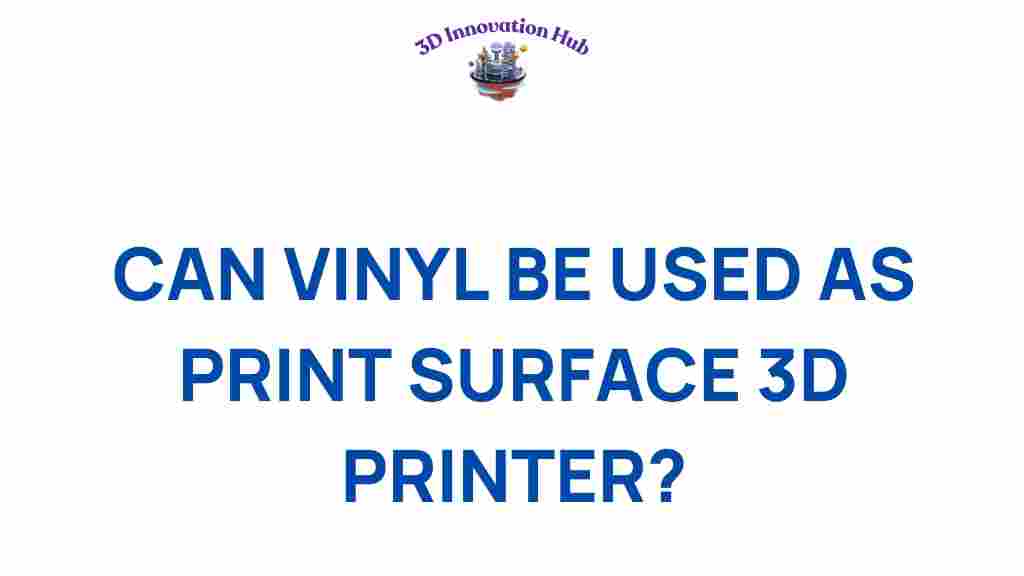Vinyl as a Print Surface: Unlocking New Possibilities in 3D Printing


Vinyl as a Print Surface: Unlocking New Possibilities in 3D Printing
In the rapidly evolving world of 3D printing, innovation in materials and technologies continues to unlock new possibilities for designers and creators. One such material that has gained attention in recent years is vinyl. Known for its versatility and durability, vinyl serves as an excellent print surface that enhances the quality and creativity of 3D printed objects. This article explores the potential of vinyl in 3D printing, its applications, and how it can be utilized to push the boundaries of design.
The Versatility of Vinyl in 3D Printing
Vinyl is a synthetic plastic polymer that is widely used in various industries for its flexibility, durability, and resistance to environmental factors. When it comes to 3D printing, using vinyl as a print surface offers a range of advantages:
- Adhesion: Vinyl provides excellent adhesion for different printing materials, reducing the risk of warping or lifting during the printing process.
- Smooth Finish: The smooth surface of vinyl ensures a clean and polished finish, which is essential for aesthetic designs.
- Cost-Effectiveness: Vinyl sheets are relatively inexpensive compared to other specialized print surfaces, making them accessible for hobbyists and professionals alike.
- Customization: Vinyl can be easily cut, shaped, and printed upon, allowing for a high level of customization in design.
Applications of Vinyl in 3D Printing
The use of vinyl as a print surface opens up a myriad of applications across multiple fields:
- Prototyping: Designers can create prototypes with intricate details and high-quality finishes, ideal for presentations and client approvals.
- Decorative Items: Vinyl is perfect for creating decorative pieces, such as wall art and signage, that require vibrant colors and durability.
- Functional Components: Its strength allows for the production of functional parts that need to withstand wear and tear.
- Educational Models: In educational settings, vinyl can be used to produce models for teaching complex concepts in a visually appealing manner.
Step-by-Step Process for 3D Printing on Vinyl
To effectively utilize vinyl as a print surface, it is crucial to follow a systematic approach. Here’s a step-by-step guide to get you started:
Step 1: Prepare the Vinyl Surface
Choose a clean, flat vinyl sheet. Ensure that it is free from dust and debris to promote adhesion. You can use a mild cleaner to wipe the surface if necessary.
Step 2: Set Up the 3D Printer
Configure your 3D printer settings according to the vinyl’s specifications. Consider the following:
- Print temperature: Adjust the nozzle temperature based on the material you are using.
- Bed temperature: If applicable, set the heated bed temperature to enhance adhesion.
Step 3: Choose the Right Filament
Select a filament that adheres well to vinyl. Common choices include PLA and PETG, known for their compatibility with various surfaces.
Step 4: Print Your Design
Load your design into the slicing software, ensuring that you select the right settings for layer height and print speed. Begin the printing process.
Step 5: Post-Processing
Once the print is completed, carefully remove it from the vinyl surface. If needed, you may sand edges for a smoother finish.
Troubleshooting Tips
While using vinyl as a print surface can yield fantastic results, you may encounter challenges. Here are some troubleshooting tips:
- Poor Adhesion: If your print is lifting, try increasing the bed temperature or applying a light coat of adhesive spray on the vinyl surface.
- Warping: Ensure that you are using the correct print temperature and that the vinyl is flat and free of any bends.
- Surface Damage: If the vinyl shows signs of wear, consider replacing it regularly to maintain print quality.
Innovative Designs with Vinyl
Vinyl opens up new avenues for creativity and design in the realm of 3D printing. Here are a few innovative ideas:
- Custom Wall Art: Create intricate designs that can be adhered to walls, combining vinyl with 3D elements for a unique aesthetic.
- Personalized Items: Use vinyl to produce personalized gifts, such as custom name plaques or decorative boxes.
- Functional Art: Design pieces that serve a purpose while also being visually appealing, such as lamp shades or planters.
Conclusion
In conclusion, vinyl as a print surface represents a significant innovation in the field of 3D printing. Its unique properties offer numerous benefits, including improved adhesion, cost-effectiveness, and the ability to create high-quality prints. By understanding the applications, following the right processes, and employing troubleshooting tips, designers can harness the potential of vinyl to unleash their creativity and produce extraordinary works of art.
As we move forward, the integration of vinyl in 3D printing technology will likely continue to expand, opening doors to new applications and creative possibilities. For more insights on 3D printing materials and techniques, check out this helpful resource.
If you have any questions or need further guidance on utilizing vinyl in your projects, feel free to reach out or explore community forums dedicated to 3D printing innovation.
This article is in the category and created by 3D Innovation Hub Team
Recent Posts
Unveiling the Secrets of Sturdy Surface 3D Printers
Discover how sturdy surface 3D printers are transforming additive manufacturing with advanced technology and innovative…
Are 3D Printing Fumes Dangerous? Unveiling the Hidden Risks
Discover the hidden dangers of 3D printing fumes and their impact on health and safety…
How 3D Printers Are Revolutionizing Human Tissue Creation
Discover how 3D printing is transforming human tissue creation and paving the way for groundbreaking…
Unlocking the Secrets: How to Effectively Multiplex Your 3D Printer
Discover how to multiplex your 3D printer for enhanced efficiency and innovation in fabrication techniques.
How Long Can Resin Sit in a 3D Printer Before It Cures?
Discover how long resin can sit in a 3D printer before it cures and affects…
Unlocking the Best 3D Printers Under $450: What to Consider
Discover the best 3D printers under $450. Our guide explores key features to help you…
View Comments